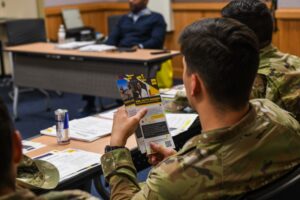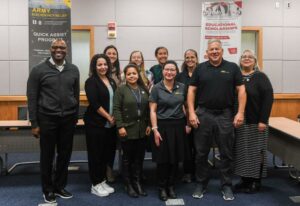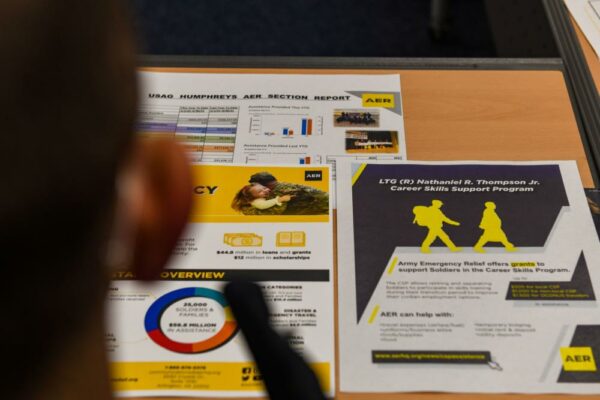Sgt. Courtney Davis | USAG Humphreys | Nov. 2, 2022
CAMP HUMPHREYS, Republic of Korea — United States Army Garrison Humphreys’ installation leaders, Soldiers, spouses, military family life counselors, and the Better Opportunity for Single Soldiers president, sat down with the Army Emergency Relief director in mini focus groups across Humphreys on Oct. 17 and Oct. 19.
Retired Lt. Gen. Raymond Mason, AER director, and retired Sgt. Maj. Charles Durr, chief of assistance for the AER program, traveled up and down the Korean peninsula visiting U.S. Army bases to speak with and receive feedback from the installations’ community members about the Army’s AER program.
A joint effort
The program was founded Feb. 5, 1942, just prior to World War II, a time when the Army was trying to build up its combat power. The Army and Air Force were joint services, and civilian pilots were being drafted to active duty. Activated pilots and their families suffered a significant loss of income due to low military wages.
“There were no programs within or outside of the Army that really provided financial assistance for those Soldiers who experienced that significant loss of income,” said Durr. “We surely didn’t have the social programs that we have today, so if you had a baby in 1942 that was out of pocket.”
The American Red Cross noticed the dilemma, donated about 1.5 million dollars in seed money, and the Army Emergency Relief program was started.
Now, 80 years later, AER has 30 different categories of assistance, seven different situational areas and 71 AER locations in which active-duty Soldiers and their dependents, Reservists and National Guardsman (who have been activated more than 30 days), surviving spouses of deceased active duty, and retired Soldiers can apply for assistance. The two forms of assistance come in grants and loans.

Assistance needed
Durr said besides emergency travel (Soldiers needing to get home to care for family members), AER also provides assistance with permanent change of station, COVID assistance, basic living, medical and privately owned vehicles.
“We help with so much more than emergency leave,” said Durr. “AER also helps assist with replacement vehicles, food, utilities, and initial deposits for rent. When COVID was bad we helped parents with educational assistance, like laptops for their children.”
All help (except for cranial helmets and special medical needs equipment) starts off as a loan with zero-percent interest. Upon further review of the client’s budget plan and income, an AER representative can decide to keep the assistance as a loan, change it to a grant or do a combination of both.
There are two ways to apply for assistance: Quick Assist Program and direct access. The Quick Assist Program was created in 2006, to give company commanders and first sergeants the tools to be able to approve Soldiers up to $2,000. With direct access, Soldiers can go directly to an AER representative and request up to $3,000. Anything from $3,000.01 to $4,000 goes to the garrison commander for approval and everything more than $4,000 goes straight to the AER headquarters to receive approval.
Along with loans and grants, AER helps spouses and dependents pursue their academic goals.
Scholarships in the amount of $2,500 to $3,000 are offered to spouses and dependents to help meet their educational goals of an undergraduate degree. Individuals are also able to request a loan or a grant on behalf of their spouse if they have a power of attorney.
Life happens
Durr and Mason said they understand “life happens” and at times Soldiers do not come into the military knowing how to manage their finances. They both have been there. Therefore, now, Soldiers are required to take financial literacy training during significant times in their career.
“By Army policy at certain points in your career and personal life you have to take this training,” said Mason. “When you: come into the Army, PCS, get promoted, get married, have kids, get divorced, and when you get out of the Army. Most of the training is video based.”
There have been some incentives offered in order to get more Soldiers to take the online-training said Mason. There are three extra modules on www.financialfrontline.org. The modules deal with doing a budget, major purchases and managing debt. Once the Soldier does the three modules, they go to AER’s website and take the quiz designed for privates through specialists. Enlisted Soldiers with a passing score of 80 percent and with an AER loan will have $200 of their loan converted into a grant.
Durr said when Soldiers request assistance they will either receive a grant or a loan. Which assistance the applicant receives depends on their financial state. He then proceeded to give examples on who qualifies for a loan and who is warrants a grant.
The first example was a single-income family with a child. The spouse decides not to work because childcare would be more expensive than the income they would bring in. The couple spends their money on household and personal essentials (rent, food, baby items, clothes and car note). The AER representative looks over their budget and does not discover anything excessive (eating out every night, buying $200 dollar shoes every paycheck). This family would receive a grant because a loan may cause them further hardship.
“On the other hand,” said Durr. “There may be a dual-military couple bringing in two incomes and are living beyond their means. They have two F150s and a BMW 440i, basically they are upside down financially. This family would be encouraged to change their financial behaviors, work with counselors, and receive assistance in the form of a loan.”

Emergency financing
Emergencies happen and the Army Emergency Relief program is there to help with emergency financing.
Mason said when a Soldier is called away due to an emergency AER assistance starts off as 50 percent loan and 50 percent grant, the grant will never be less than 50 percent. However, a grant can increase to 100 percent, depending on the individual’s financial situation.
In cases where Soldiers and or their families are on leave and need financial assistance, they can call the American Red Cross at 1-877-272-7337 and do a reciprocal support agreement. The Red Cross will process the case and will send it to AER for approval. The funds will be disbursed to the client and AER will reimburse the Red Cross. The Red Cross can also be used as an after-hours and weekend resource if there is no one available in the AER office.
Service members helping each other
Army Emergency Relief has been around 80 years with the motto of “Soldiers Helping Soldiers.” The program is funded through Soldiers’ donations and is also opened to help members from other services when they are not near their port or base.
“The Air Force has a similar organization, the Air Force Aid Society,” said Mason. “The Navy and Marines have the Navy-Marine Corps Relief Society and the Coast Guard has their own relief. The good part, though, is any military member can go to any other relief agency and be supported. You just must go to the nearest one within 50 miles of your location.”
“Leave no comrade behind on the battlefield, same holds true at your home station,” said Mason. “Help your battle buddy. Take care of your squad.”


